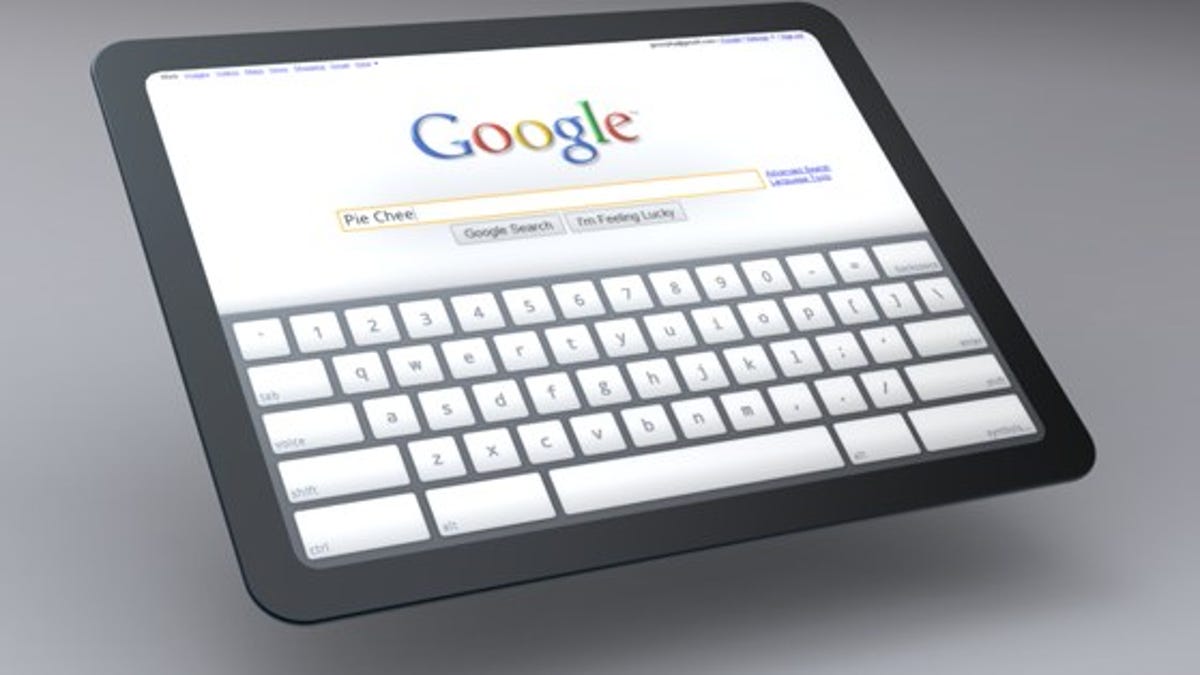Google begins tablet version of Chrome OS
The browser-based operating system is headed for touch-screen tablets. But Chrome OS competes not just with Apple's iPad, but also Google's own Android OS for tablets.

Details in Google's source code reveal that company programmers have begun building a tablet version of Chrome OS, its browser-based operating system.
The work isn't a surprise, given that Google created mock-ups of a Chrome OS tablet more than a year ago. But it does indicate that a tablet incarnation of Google's Web-app operating system is a near-term priority, not just an idea.
Google acknowledged the tablet version of Chrome OS but wouldn't discuss details such as when the project's first version will be done. "We are engaging in early open-source work for the tablet form factor, but we have nothing new to announce at this time," the company said in a statement.
Chrome OS tablets, though, are not first on the list, the company said: "Chrome OS was designed from the beginning to work across a variety of form factors. We expect to see different partners build different kinds of devices based on Chrome OS, but for this initial release we are targeting the notebook form factor."
Chrome OS has been evolving since Google announced it in 2009. Initially it was aimed at Netbooks, the small, low-end laptops. But the first incarnation of Chrome OS--a pilot release intended for developers and testers rather than ordinary customers--arrived in a more polished laptop package called the Cr-48.
A tablet version of Chrome OS, though, raises a big question about Google's strategy, because the company's tablet version of the Android operating system, Honeycomb, is just now arriving on the market with Motorola's Xoom and other products designed to compete with the leader of the tablet market, Apple's iPad.
Signs of Chrome OS for tablets
A number of changes in Chrome and Chrome OS source code that arrived in March and April reveal the tablet work. Among them:
• The "user-agent string" text that browsers supply so Web servers can deliver the appropriate version of a Web site--for touch user interfaces. The string includes the term "CrOS Touch," not just CrOS as before.
"This lets Web sites that are already customizing for tablet experiences easily adapt to support tablet ChromeOS devices," the programming change log notes.
• A "virtual keyboard" with a number of keys--tab, delete, microphone, return, and shift, for example--drawn in SVG so they can be shown by a browser. Screen keyboards are, of course, a necessity with tablets.
• A variety of moves to make the browser more touch-friendly, for example by increasing the space around items to make it easier to select them with a touch interface.
• A revamped new-tab page (which people see when they open a new, blank tab) that's "optimized for touch." The current page shows an array of Web applications downloaded from the Chrome Web Store, but the modified version adds multiple screens of icons in the style of iOS devices.
The orientation of the new-tab page, but not its size, will change when the device is rotated, according to the new-tab page's coding annotations. "Note that this means apps will be reflowed when rotated (like iPad)," the annotation said.
The CSS code for the new-tab page also indicates that programmers would like to be able to move icons around the page, preferably with animation.
Pick a tablet, any tablet
So with Android and Chrome OS tablet software under development, what's Google's top tablet priority?
Clearly, the answer today is Android. It's at the forefront of Google's mobile strategy and is a commercial success, at least in phones. Tens of thousands of Android applications are available today, and even Google rivals such as Yahoo and Microsoft are offering software.
Chrome OS, by comparison, is immature and conceptually a greater leap from prevailing software development patterns. That's because Chrome OS solely runs apps on the browser, not on its underlying Linux operating system embedded under the covers.
Related links
• Google shows off Chrome OS tablet ideas
• Rumor: Chrome OS tablet coming in November
• Google plans Chrome-based Web operating system
• Google Cr-48 Chrome hardware pilot program: 'Not for the faint of heart'
There are abundant Web sites and Web apps that Chrome OS users can use today, of course, and some, like Google's Gmail site optimized for Apple's iPad, are designed with a touch user interface already. But the tools for building advanced, interactive, high-performance Web apps today just don't match what's possible with apps that run natively on a mobile device or computer, and most people today aren't ready to live solely in the cloud.
Timing also isn't on Chrome OS's side. The project had been set to launch in 2010, but has been delayed to midway through this year, though the Chrome Web Store used to bookmark and purchase Web apps is live.
Google can let both tablet projects duke it out internally and in the market. Or, if Google co-founder Sergey Brin is to believed, Android and Chrome OS might merge into a single project.
It's not a simple matter of some internal Darwinian process within Google to let the be best product survive, though. That's because there are external parties involved: hardware partners, developers, retailers, and customers.
Each of these groups must be won over, persuaded that the new ecosystem is worth their investment of time and money.
Google's modus operandi--release early and iterate often--is a lot harder to pull off when others are involved. Web applications and native Android applications are by no means mutually exclusive, but developers with finite resources can't be blamed for trying to figure out where to place their bets.

